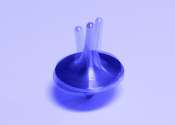Tiny magnets, huge fields: Nanoscale ferromagnetic electrodes create chemical equivalent of solid-state spin valve
In the study of ways to determine the position of and manipulate magnetic nanoparticles – a capability that would benefit a wide range of applications – there's good news and bad: While a magnetic gradient force field ...








